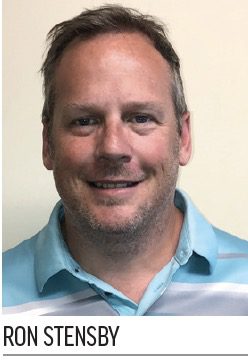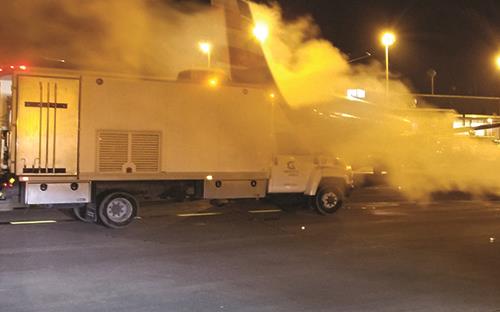Minneapolis-St. Paul International Airport (MSP) recently completed a roughly $3.5 million project designed to prevent the glycol used to deice planes from potentially seeping into groundwater. By sealing select sections of concrete storm sewers with leak-proof liners, the airport avoided the higher cost and disruption associated with excavating and replacing pipes.
 Minneapolis-St. Paul International Airport (MSP) recently completed a roughly $3.5 million project designed to prevent the glycol used to deice planes from potentially seeping into groundwater. By sealing select sections of concrete storm sewers with leak-proof liners, the airport avoided the higher cost and disruption associated with excavating and replacing pipes.
Minneapolis-St. Paul International Airport (MSP) recently completed a roughly $3.5 million project designed to prevent the glycol used to deice planes from potentially seeping into groundwater. By sealing select sections of concrete storm sewers with leak-proof liners, the airport avoided the higher cost and disruption associated with excavating and replacing pipes.
Performed in two stages, the project included lining 48 segments of storm sewers totaling 7,288 feet of pipe. The trenchless lining technology used is known as cured-in-place pipe, essentially a resin-impregnated felt liner that, once cured, creates an impregnable pipe within a pipe.
The seeds of the project were planted several years ago when the Minnesota Pollution Control Agency (MPCA) expressed concerns about potential seepage of glycol from airport storm sewers into groundwater, explains Pat Mosites, project manager for the Metropolitan Airports Commission.
The state environmental agency was worried that such seepage could impact the nearby Minnesota River, which drains into the Mississippi River about two miles to the east. Glycol consumes oxygen in water as it degrades, which can stress fish and other aquatic wildlife.
|
facts&figures Project: Lining Storm Sewers to Prevent Potential Glycol Seepage Location: Minneapolis-St. Paul Int’l Airport Cost: $3.5 million Funding: Airport revenue bonds Phase One: Aug. 2018 – June 2019 Phase Two: August through Sept. 2019 Engineering Consultant: TKDA Project Scope: Lined 7,288 ft. of concrete storm sewers; rehabbed 50 manholes
Pipe-Lining Contractors: Granite Inliner; Pipeline Inspections: Visu-Sewer; Hydro Klean Manhole Sealing: Visu-Sewer; Thul Construction Key Benefits: Protects nearby eco-sensitive river from contaminants; pipe-lining is faster, less expensive & significantly less disruptive than excavating & replacing pipes |
The Minnesota River runs near the southeast side of the 3,400-acre airport and the majority of airport stormwater drains into it. As such, the agency asked MSP to inspect the storm sewers to see if any were leaking, Mosites explains.
All pipes passed the inspection, but some were close to the lower end of acceptable leakage tolerances, which could eventually lead to groundwater inflow and infiltration. So after reviewing the inspection results, MPCA and MSP officials worked out an agreement regarding which pipes should be lined.
TKDA, a design/engineering and construction management firm based in St. Paul, consulted with the airport about the project.
General revenue airport bonds issued by the Metropolitan Airports Commission, which operates MSP and six other area airports, paid for the project. Last year, MSP handled nearly 39.6 million passengers and 406,076 operations.
Going With the Flow
The first stage of the project cost about $1 million and ran from late August 2018 to June 2019. Visu-Sewer Inc. lined 17 storm sewer segments totaling 1,964 feet. The pipes collect glycol and stormwater runoff from the airport’s 10 in-gate deicing operations. The company also resealed 10 manholes to eliminate groundwater inflow and infiltration.
Granite Inliner LLC, a wholly owned subsidiary of Granite Construction Inc., performed the $2.5 million second phase during a six-week stretch last September and October. The project involved lining 31 segments of storm sewers and totaled 5,324 feet of pipe. In addition, Thul Construction resealed 40 manholes as a subcontractor.
Most of the pipe-lining was performed on storm sewers that run under in-gate deicing areas. When the pads are in use during winter, the airport seals off sections of those sewer pipes with mechanical plugs to hold glycol and water runoff. “It’s like putting in little dams,” Mosites explains.
A contractor periodically pumps out these sealed-off segments with a vacuum truck and then tests the glycol content. All the collected water is pumped into three underground concrete storage vaults; each one can hold slightly more than 3 million gallons.
Water with more than 2% glycol content is pumped into one of the three underground vaults. Water with less than 2% glycol content is pumped into the other two vaults. All the vaults are lined to prevent leaking, notes Mosites.
A recycling company then collects the water with a higher concentration of glycol, which ultimately is used to make products such as hydraulic fluids for the automobile industry. The water with a lower concentration of glycol is discharged into a sanitary sewer line that is connected to a local municipal treatment plant. Discharge rates are regulated to ensure that the plant isn’t overwhelmed, Mosites says.
MSP also has five dedicated deicing pads, one at both ends of the two parallel runways and one at the north end of its crosswind runway. Stormwater runoff from three of the pads drains directly into the storage vaults via pipelines. Runoff from the other two pads gathers in plugged-off sewer lines, where it’s collected by vacuum trucks and pumped into the appropriate vaults.


Trenchless Technology
Lining pipes is a viable solution for leaking lines only if the host pipe is structurally sound. The so-called trenchless technology has become increasingly popular and accepted during the last decade or so because it eliminates the need to excavate and replace substandard pipe—a more time-consuming and typically more expensive proposition.
While cured-in-place pipe technologies and processes vary by liner manufacturer, here’s how a typical installation works: Crews begin by thoroughly cleaning the pipe, typically with high-pressure water. Then they use robotic wheeled cameras to inspect the pipe.
At MSP, Visu-Sewer inspected and cleaned the pipes during the first phase of the project. During the second phase, Granite Inliner inspected the pipes and Hydro Klean cleaned them, working as a subcontractor.
After the prep work is completed, contractors use a winch and a cable to pull a felt liner that is fully saturated with epoxy resins into a pipeline, usually running from one manhole to another. Then either water or compressed air is used to inflate the liner until it fully conforms and adheres to the host pipe.
After the liner cures, it creates a like-new pipe inside the host pipe that should last for at least 50 years. Some liners cure by ambient temperature while other processes use hot water, steam or even small “light trains” with ultraviolet lights that slowly travel through the pipe on wheels.
 Ron Stensby, a project manager for Granite Inliner, notes that crews working at MSP used steam to cure smaller-diameter pipes, a process that takes about one to one and one-half hours, and hot water to cure larger-diameter pipes, which takes about 12 hours. The company makes its own liners.
Ron Stensby, a project manager for Granite Inliner, notes that crews working at MSP used steam to cure smaller-diameter pipes, a process that takes about one to one and one-half hours, and hot water to cure larger-diameter pipes, which takes about 12 hours. The company makes its own liners.
Timing is Everything
The lining work was performed at night to minimize disruption to airport and airline operations. MSP never had to close down, Mosites notes.
“Some of the lining occurred in gate areas,” he explains. “We tried not to interfere with both tenants and airlines by working within their schedules…But at times we had to close some gates, so we had to ask airlines to use different gates.
“Projects like this almost always required dancing around the airlines’ schedules,” he adds. “But they realize that the end product supports their operating goals as well. We have good working relationships with airlines here at MSP.”
Working on airport grounds and completing the associated badging process made the project more involved than some of Granite Inliner’s other projects. “It took a lot of coordination. But once we figured everything out and got it all scheduled, it went very smoothly,” Stensby reports.
Paul Blum, a senior registered engineer with TDKA, notes that it’s challenging whenever work occurs inside a secure airport perimeter. In this case, much of the work occurred at gates near areas where airplanes are parked, which upped the ante a bit.
 “Sometimes we had to vacate a site on short notice and jump over to a different manhole because an airline had a plane unexpectedly coming in late at night,” Blum comments. “But we do a lot of work at airports, so were used to dealing with things like that.”
“Sometimes we had to vacate a site on short notice and jump over to a different manhole because an airline had a plane unexpectedly coming in late at night,” Blum comments. “But we do a lot of work at airports, so were used to dealing with things like that.”
Keys to Success
Collaboration, communication and coordination among all stakeholders were critical to the projects’ success—especially with the Minnesota Pollution Control Agency, notes Mosites. “We had to see the situation from their point of view as well as get them to see the situation from our point of view,” he reflects.
Investigative pipeline inspections were performed early on, followed by a report that helped officials from MSP and MPCA form and agree on an action plan. In all, the projects took about three years from initial talks to completion.
“Initially, we were projecting it would take about five years,” Mosites notes. “But the pipe inspections helped us shorten that to three years because it narrowed the amount of lining required.”
Getting to know all the key stakeholders also was critical, he adds. Establishing familiarity, particularly with the state agency and airlines, nurtured a collaborative atmosphere that led to faster and easier agreement on solutions, says Mosites.
“The key is getting to know the people in the trenches,” he concludes. “When you can collaborate, everybody wins.”



